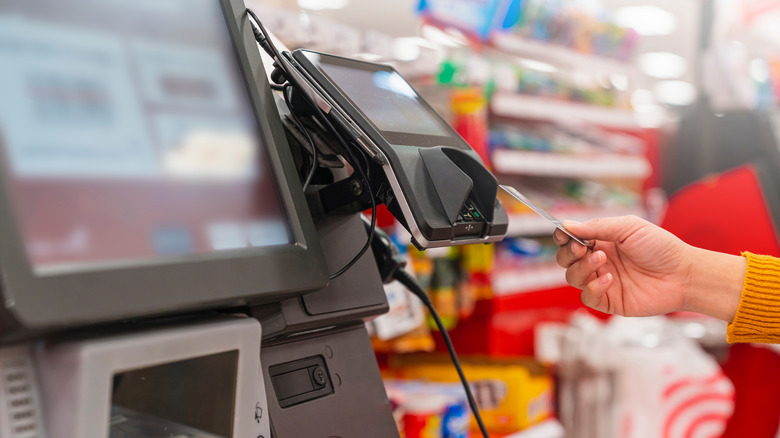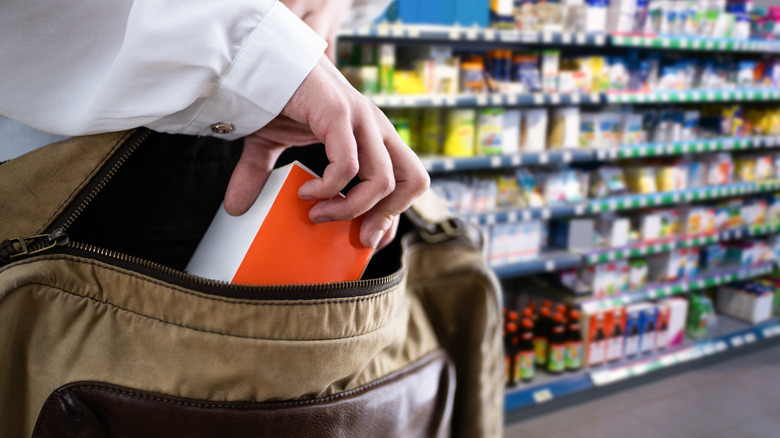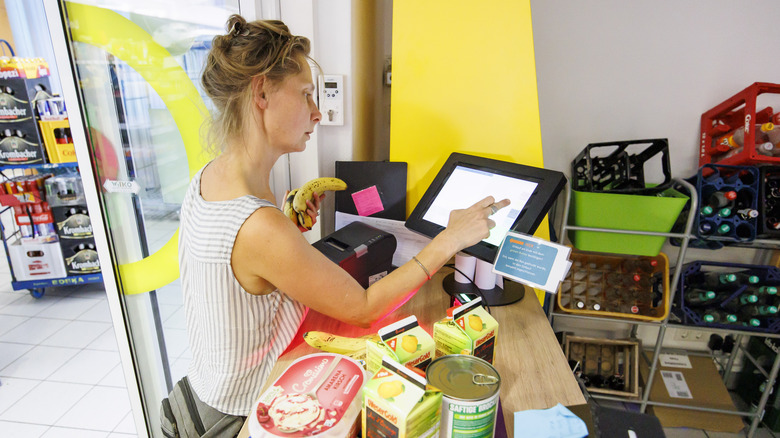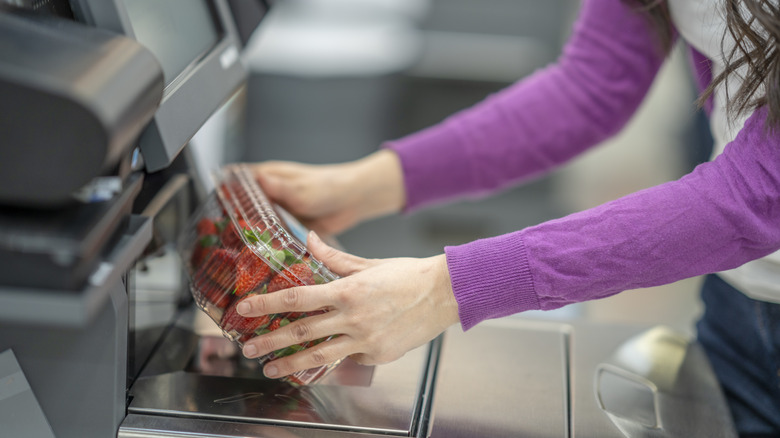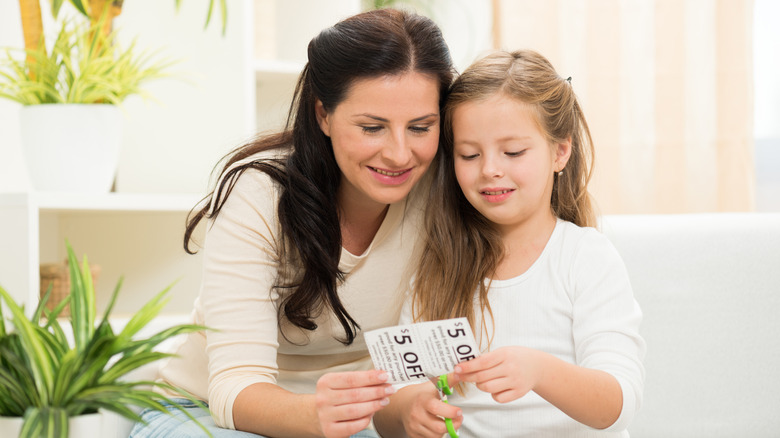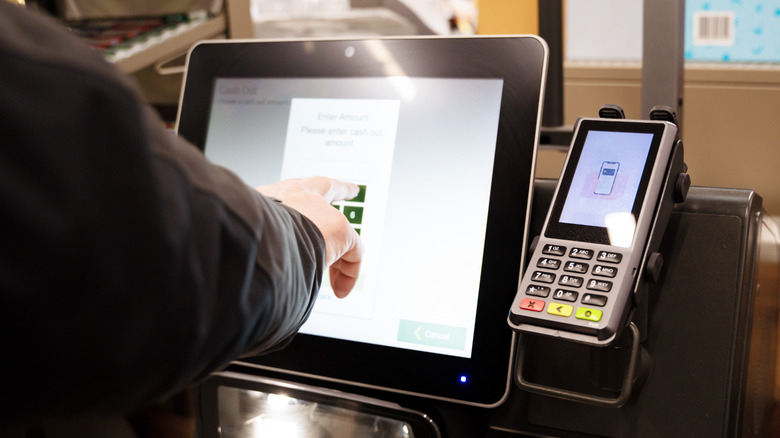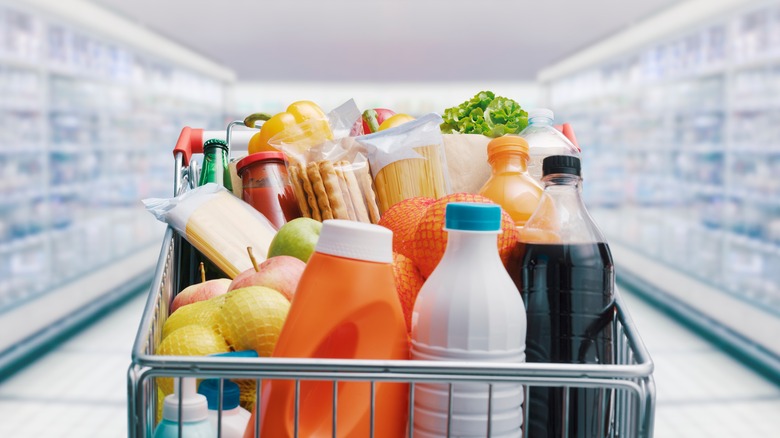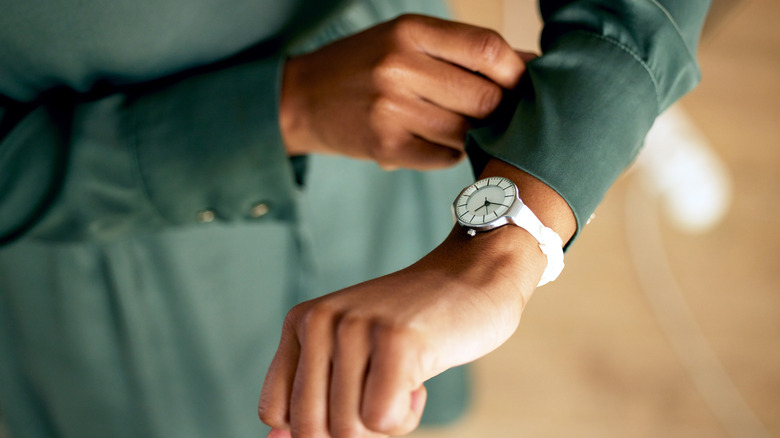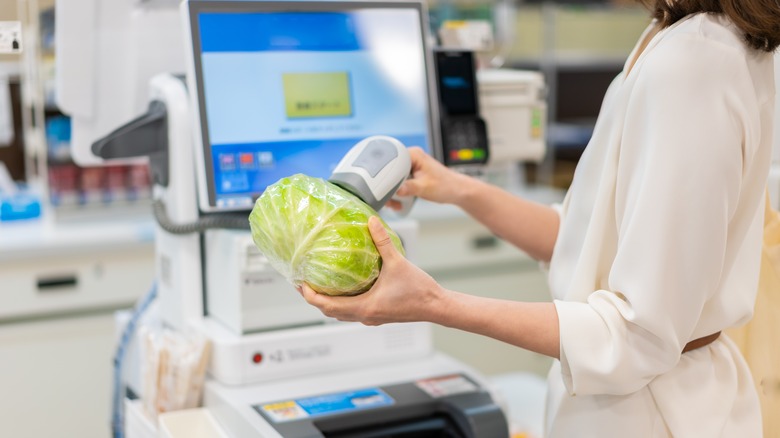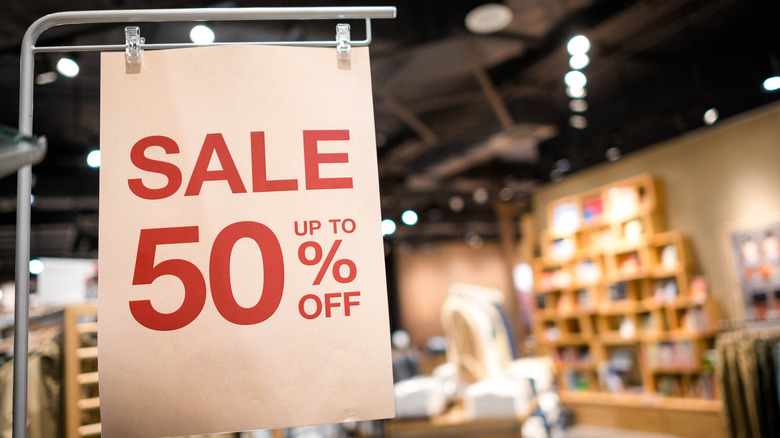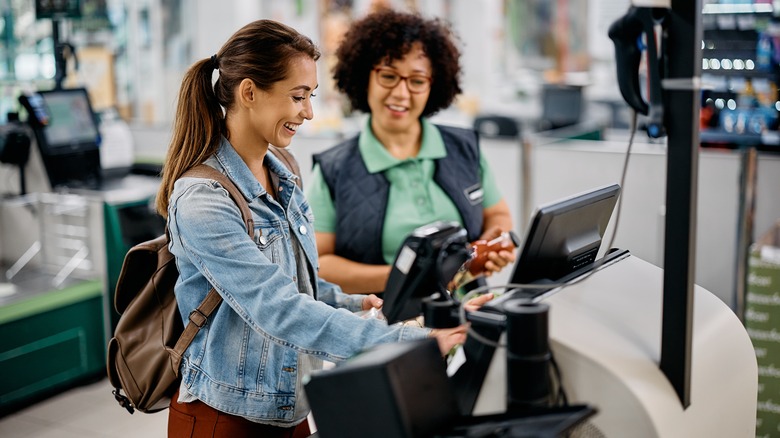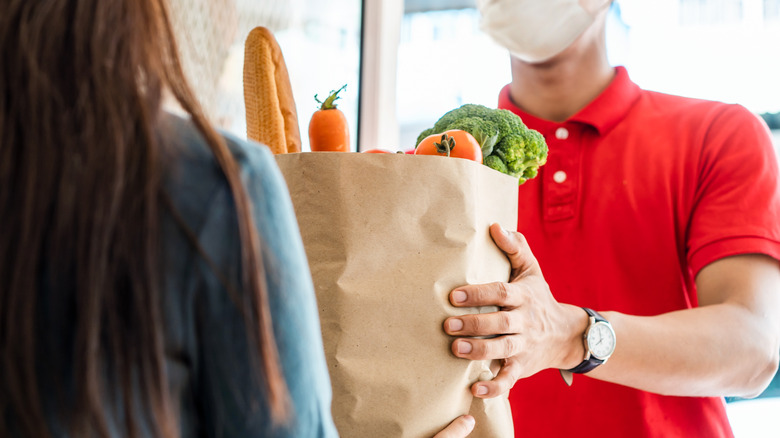What Employees Want You To Know Before You Use The Self-Checkout
Whether you love or hate the grocery store self-checkout, one thing's for certain: It's here to stay. Along with the undeniable popularity of this convenient (though controversial) way of paying for purchases comes the understandable headache of learning how to simply operate the darn thing. From unfamiliar buttons to unsolicited outcries from the machine itself, it's no wonder some people feel anxious when using this familiar yet daunting payment machine.
We've done a bit of research and have discovered a few tips many employees wish customers knew about self-checkouts. Whether you're new to this or have been utilizing the self-service kiosk for years, there's plenty to discover about these modern-day payment machines, with new updates seemingly popping up all the time.
So, without further ado, let's get into everything you need to know about self-checkout machines, including helpful suggestions from employees to score you a smoother and more effortless self-checkout experience.
Stealing is easier, but you'll likely still get caught
If you've ever thought about how easy it would be to steal an item at the self-checkout, you aren't alone. Whether you're a bonafide crook or a devoted and honest patron, most of us have likely reasoned that because there is no one actually watching you scan your items, you could easily skip out with a freebie or two. But are these units really that unmonitored?
Not so fast. While the self-checkout may seem like an easy way to bypass employees and cop yourself a few free things, the truth of the matter is that attempting to steal from these convenient grocery store kiosks could land you in hot water quicker than you'd think.
For example, the infamous "banana trick" is known to encourage customers to scan a cheaper item in place of one that is more expensive in an attempt to save money. While this naughty trend has undoubtedly garnered a lot of attention, the deed is still very likely to get you busted. Not only will the weight-sensitive scanner call your bluff, but some units have built-in cameras to track your every move. Not enough to scare you? How about the fact that employees at certain stores can literally see what you're scanning and pause your self-checkout at any time to check for suspicious activity? Yep, not worth it.
You might get asked for a tip
If your self-checkout unit randomly asks you for a tip, don't be alarmed. Despite the fact that you've just shopped for, scanned, and loaded your cart by yourself, your checkout unit just may badger you for a tip anyway. The reason? Some employers argue that by tipping the machine, you're actually benefiting store staff.
Despite that seemingly charitable notion, some customers disagree with the practice, claiming it to be a form of emotional blackmail, as many people will enter a tip amount only to avoid feeling like a cheapskate. Furthermore, there's no actual proof that these tips will go to employees, so who's really benefiting here? We have no idea. But there are some researchers out there that believe this may just be another way corporations are putting more financial strain on customers. Tip requests from self-service kiosks could be a devious way of generating more revenue while allowing customers to foot the bill.
Self-checkouts are often overly sensitive to weight
If the phrase "there's an unexpected item in the bagging area" doesn't haunt you at night, we don't know what will. Anyone who has ever had the pleasure of using a self-checkout unit knows the ills associated with overly sensitive weighing areas, and trust us ... it isn't pretty.
Originally designed to keep theft at bay, scales in the bagging area enable self-service kiosks to check if the items you've scanned match the weight of what's in each bag. While this is a smart and proactive way to counteract the occasional sly bandit, it certainly isn't convenient for the rest of us. The startling demand to remove the "unexpected item from the bagging area" could be triggered by something as innocent as a purse, a brush of the leg, or a toddler's sweet little hand eagerly digging after gummy bears.
Regardless, there's no denying that this is one of the more annoying (and embarrassing) aspects of the self-checkout. Consider yourself warned.
You can still use your coupons
Some people that use self-checkout worry that they won't be able to use their coupons or that doing so may hold up the line. Indeed, if you've got a wallet full of coupons you have yet to sort through, most people would appreciate you taking the time to locate them before approaching the register. However, once you've got everything sorted, there's no reason why you can't use them at the self-checkout; in fact, you'll likely find that it's quite easy to do.
To start, begin scanning the purchases in your cart. Once all items are scanned, browse your screen for the "coupons" button. Note that you may have to hit "finish and pay" before this button will display. From there, scan your coupon and follow the directions for how to dispose of your used coupon. That's it! If no "coupons" button appears, you can try swiping the coupon on the main screen, as some retailers handle coupon scans this way.
If all else fails or you receive an error message indicating your coupon is not valid, click the help button to give the store clerk a ring. Yes, your lane light will blink, and yes, there will be eye-rolls from the long-suffering patrons behind you. But, hey, you wanted to know how to use your coupons at self-checkout, and this is how you have to do it.
Units can sometimes be weirdly glitchy
Did your self-checkout unit give you grape tomatoes instead of change? It isn't unheard of. But even if you haven't had an experience this extreme, we're willing to bet you've encountered at least one or two glitches that have left you flustered and in frantic search of the self-checkout team manager.
If you're looking to save time using the self-checkout, add this to the ever-increasing list of why your speedy experience may not turn out so speedy. Glitches range from not allowing customers to use certain forms of pay to alternating the machine's "unexpected item in the bagging area" with its "return item to bagging area" rant so that there ultimately is no satisfying its repeated pleas. All of this comes after you've already scanned your items and are faced with waiting patiently as an already overworked clerk darts from one blinking light to another — what a joy.
It may or may not be the best for large orders
If you've ever caught yourself wondering, "Why do so many people approach the self-checkout with a cart full of stuff?" you aren't alone. There are plenty of people, employees included, that can't stand to see people with overflowing carts drawing anywhere near the self-checkout. Still, it's important to note that though this proves an annoyance for some, not all employees will resent you for doing this. In fact, there are many that will patiently and quietly wait while you do.
The reason? Unless there's a sign posted somewhere that states the self-checkout is limited to a set number of items, it's fair to assume that this self-serve kiosk is pretty much fair game for whoever would like to stop on through.
Now, before you get all giddy and start loading up your cart, there are a few things you might want to consider. Know that while some self-check lanes are designed to handle larger orders, others feature crammed bagging areas that may make ringing up your hefty haul more difficult than you'd hope. Moreover, you might have to deal with the potential for huffy customers behind you who may only have a few items and would rather you not be standing there. But hey, unless there's a sign posted stating otherwise, just remember this is a free country — you scan what you want.
You can adjust your unit's volume ... but shouldn't
We've said it once, but we'll say it again: That annoyingly piercing voice on the self-checkout unit can be beyond traumatizing. Whether it senses additional items in the bagging area or your card has been declined for unforeseen reasons, these checkout kiosks are sure to air all your business in the loudest, most obnoxious way possible.
What you may not know is that while these kiosks certainly seem out to get us, the truth is that we can beat them at their own game with one small move ... the mute button. That's right. You can actually mute your self-checkout kiosk (or at least turn it down) so that your business stays yours and you can successfully avoid nosey glances from the person checking out beside you. But should you do it? Well, that's another question entirely.
While this golden tip seems like an easy win for most of us, the truth is that employees really wish you'd stop doing this. There are myriad reasons employees need the sound on the self-checkout units turned up, but the consensus seems to be that muted kiosks make things harder for clerks overall. Not to mention, your fellow patrons may feel a bit bewildered upon approaching a self-checkout that isn't actually screaming at them; thus, they may begin to believe something is wrong. Take it from us: Though adjusting the sound seems nice, it's probably best to just let it be.
Using the self-checkout may or may not actually save you time
There's no denying it — America runs on speed. Fast cars, fast money, fast food ... you get the drift. Thus, it isn't hard to understand why Americans use the self-checkout because they think it's faster than traditional cashier lanes. But is this actually true?
In theory, we believe it likely is. But that's only when things go smoothly. When you consider waiting for the self-checkout alongside people with carts overflowing with cat food, water, and other heavy items, or the avid coupon clipper who forgot to sort their coupons the night before, well, you can see how the minutes could begin to add up.
On the flip side, because there are so many registers available, it is possible that the occasional hold-up won't cause you to have to stand there for hours on end. Still, if the lines are long enough and enough snafus occur, don't be surprised if you end up waiting in line for just as long, if not longer, than you would have if you had chosen a traditional checkout lane.
There's a method to the madness for ringing up produce
Does the thought of ringing up loose produce yourself cause you to shudder? If so, it's time to breathe easy. Yes, it is more taxing to scan these items at the self-checkout, but unless you have a plethora of fruit and veggies, most people agree that you shouldn't let it stop you from using this convenient store kiosk.
When approaching the scanner with loose produce, take a second to quickly look over the item for a barcode. Once you find it, many employees will tell you to simply scan that barcode.However, it's not always that simple.
While it is true that there's sometimes a barcode on produce to scan, it is also true that this barcode can be virtually impossible to get the scanner to pick up. After all, it's often very tiny, and when affixed to a round apple or orange surface, for example, it's easy to get flustered trying to scan each item. Instead, you can punch in your produce manually using the several-digit PLU code often found on fruits and veggies. If that fails, you can always use the lookup button on the home screen to select the name of the item you wish to purchase. It may not seem as quick, but if those microscopic awkwardly placed barcodes aren't working anyway, we argue that doing it the manual way may prove faster.
Purchasing heavy items can be a real pain
Do you have heavy dog food, sodas, or multiple cases of bottled water? If so, then don't forget to also bring your patience with you to the self-checkout. Unless the store you're shopping at has been graced with hand-held scanners at each unit, you may have to wait on an employee to help you scan each one of those bad boys. Even once the clerk arrives, you'll be met with another challenge, and that's finding the barcode. If you've thought ahead, you'll likely already have that already facing upwards, but if you're new to this, it'll probably be hiding in the exact opposite direction of where you need it. Have fun helping the kiosk employee flip those massive items as you both painstakingly search for that darned code.
As you can probably tell, between waiting for help and locating bar codes, your self-checkout experience could take a lot of time, especially if your heavier items aren't your only purchases. Still, if there's only one or two bulky things you're trying to buy, you'll probably get along just fine.
You can still use your own bags
In case you're wondering, yes, you can use reusable bags when using self-checkout, but know that doing so comes with caveats. For starters, many lament the fact that bringing your own bag requires you to hit a button which sometimes alerts the store clerk to come and check your bags before you begin scanning. Of course, this process means more time spent waiting and less time getting in the checkout line when you probably don't feel like shopping in the first place. And for some, the waiting game might not be worth the hassle.
Thankfully, not every self-serve kiosk requires you to wait, and there is even a way around it even if they do. If your store clerk seems very busy and unlikely to get to you in a decent amount of time, try scanning your first item, placing it in your reusable bag, and then placing the bag (with its contents) into the bagging area. The scanner will pick up the weight of the item but isn't likely to flag the weight of the bag too.
If this doesn't work, then you'll just have to wait or use the bags that are already there. Alternatively, you can scan all of your items, pay, and then place them in your reusable bags; but honestly, that's too much work for us. You do you, though.
The pricing may not reflect what you saw on the shelf
It pays to double-check the prices of the stuff you scan, especially when you are using the self-checkout. According to some shoppers, self-scanning kiosks are notorious for pricing items incorrectly, and unless you catch them in the act, you're likely to walk out having paid a price much higher than you anticipated.
So, how can you avoid this? If possible, always take note of how much your items are priced on the shelf in order to catch the inflated price at the self-scan register. Can't remember all those items? No problem. Try snapping a photo of the shelf price to present to the self-checkout clerk in the event that things go awry. They'll appreciate your efforts and, hopefully, honor the price, too.
In addition, if you pick up an item that is marked with a barcode clearance sticker, be sure that you scan it instead of scanning the product's actual barcode. This is just yet another way to save yourself time and headaches.
Please be patient
Despite its flaws, we think most will agree that the self-scanning kiosk is worth trying out, especially if you don't want to be caught in long cashier lanes. From saving time to preserving social energy, there's much to be said about quickly scanning your own items before heading on your merry way.
Still, because self-checkouts have become so popular, it can put quite a strain on clerks who have to manage self-scanners alone. Think about it. There are usually four or more registers going at once, with one person running from machine to machine trying to handle everything from kiosk quirks to crooks and even unaccepted payment methods. Not only this, but they then have to help patrons lift heavy items, assist new shoppers with PLU barcodes, take and adjust coupons ... the list goes on. Thus, it's important to remember that though you may need help right away, you still understand that the self-checkout lane can be a busy place. As such, exhibiting a bit of patience in this scenario is certainly a virtue.
It's not for everyone
Last but not least, sometimes it's helpful to remember that self-checkout machines simply aren't for everyone. Despite the supposed convenience of self-serve kiosks, there are some people who'd rather enjoy a good old-fashioned human interaction when buying groceries
Moreover, some have taken the stance that not only are traditional check lanes more familiar, but they also negate the risk of employees losing their jobs to a machine. There are many that fear that because of the introduction of self-service kiosks, the common cashier will no longer have a place in the grocery world, especially given the rise in popularity of these machines in retail stores.
Could self-checkout kiosks actually cause people to lose jobs? Who knows. But despite what we may think, the truth of the matter is that some people would rather forgo the self-checkout experience altogether. And you know what? That's totally fine.
